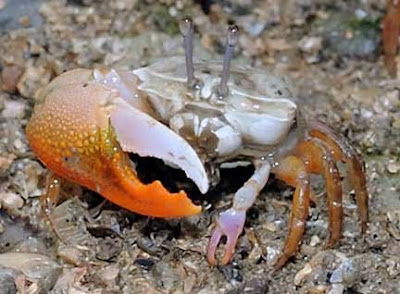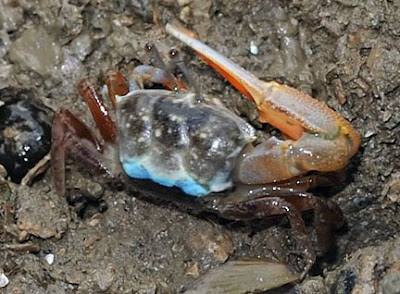Fiddler crabs are among the most engaging and amusing animals to be encountered at low tide during daylight.
There are particularly large Orange fiddler crabs (Uca vocans) under the Ubin Jetty. Fiddler crabs are identified by the shape of the enlarged pincer of the male crab. In the Orange fiddle crab, the enlarged pincer has a bumpy or pimply outer face. The tips of the claws are flattened and sabre-like. The immobile lower finger is orange or yellow and has a long groove on the outside.
Fiddler crabs are identified by the shape of the enlarged pincer of the male crab. In the Orange fiddle crab, the enlarged pincer has a bumpy or pimply outer face. The tips of the claws are flattened and sabre-like. The immobile lower finger is orange or yellow and has a long groove on the outside.
There is a row of bumps on the innder surface of the enlarged pincer too. Only the male fiddler crab has this huge single claw that may be as large and as heavy as the rest of the crab's body!
Only the male fiddler crab has this huge single claw that may be as large and as heavy as the rest of the crab's body! This enormous claw is not used to hunt or crush food. It is too small to effectively fend off most predators. Instead, it is used to attract females and to intimidate rival males. The male waves his large claw in a style and rhythm unique to his species in order to attract the ladies. Fiddler crabs got their name for this behaviour, which resembles a musician playing on his fiddle.
This enormous claw is not used to hunt or crush food. It is too small to effectively fend off most predators. Instead, it is used to attract females and to intimidate rival males. The male waves his large claw in a style and rhythm unique to his species in order to attract the ladies. Fiddler crabs got their name for this behaviour, which resembles a musician playing on his fiddle.
Is the enlarged claw on the left or on the right? As this photo shows, it can be on either side.
As this photo shows, it can be on either side.
The huge claw of the male fiddler crab is so big it misses his mouth! So he cannot feed with his huge claw and has a much smaller feeding claw. Females, however, have two feeding claws and can thus feed much faster.
Females, however, have two feeding claws and can thus feed much faster.  What do they eat? Fiddler crabs eat the thin coating of detritus on sand grains. They scoop sand to their mouthparts with the feeding claws that are spoon shaped and fringed with hairs. The bristle-like mouthparts scrape the sand grains clean of any edible titbits.
What do they eat? Fiddler crabs eat the thin coating of detritus on sand grains. They scoop sand to their mouthparts with the feeding claws that are spoon shaped and fringed with hairs. The bristle-like mouthparts scrape the sand grains clean of any edible titbits. The body and legs of the Orange fiddle crab can be of different colours and patterns.
The body and legs of the Orange fiddle crab can be of different colours and patterns. In fact, it is said that fiddler crabs can change colours. Sometimes, they appear different at night and during the day. In some species, the males brighten up during mating season. This makes it challenging to identify the different species of fiddler crabs by their colours alone. The species are generally distinguished by the structure of their claws rather than by colours alone.
In fact, it is said that fiddler crabs can change colours. Sometimes, they appear different at night and during the day. In some species, the males brighten up during mating season. This makes it challenging to identify the different species of fiddler crabs by their colours alone. The species are generally distinguished by the structure of their claws rather than by colours alone.
Fiddler crabs belong to Family Ocypodidae. Another member of this family commonly encountered are the Sand bubbler crabs (Scopimera sp.). This tiny ball-shaped crab resembles the little sand balls that it creates all over the shore at low tide. It has a somewhat spherical body with pincers that are long, flattened and downward-pointing.
This tiny ball-shaped crab resembles the little sand balls that it creates all over the shore at low tide. It has a somewhat spherical body with pincers that are long, flattened and downward-pointing. Like the Fiddler crabs, the Sand bubbler crab eats the thin coating of detritus on sand grains. Sand grains are scraped up with the downward pointing pincers and brought to the mouthparts that then sift out any tiny food particles. The shifted sand is then discarded in a little ball.
Like the Fiddler crabs, the Sand bubbler crab eats the thin coating of detritus on sand grains. Sand grains are scraped up with the downward pointing pincers and brought to the mouthparts that then sift out any tiny food particles. The shifted sand is then discarded in a little ball.
As it eats, a little path is scraped out on the sand from the burrow entrance. Little balls of sifted sand is piled up on either side of this path. As a result, there is often a 'path' among the piles of sand grains leading from the burrow entrance.
The Fiddler crabs and Sand bubbler crabs disappear into their burrows when they sense footsteps. So while you may not see them, they are in the soft sand and mud. So please watch your step and don't squash them!
Other blog posts about these crabs
- Fiddler crabs galore video clip of a male crab on Andy's sgbeachbum blog
- MORE fiddler crabs video clip of a female crab on Andy's sgbeachbum blog

No comments:
Post a Comment